
In its simplest form, a dust collection system can be described as similar to a vacuum cleaner. The dust collection ductwork is the hose and wand that draws the dust away from the machine creating pollutants. And the dust collector is the vacuum cleaner filtering dust and returning clean air either to the building or outside.
Dust collection is used to enhance worker safety, providing a cleaner, healthier work environment, and helping eliminate the risk of fires and possibly explosions, created by the buildup of “combustible dust”. Cleaner environments also promote greater machinery efficiency.
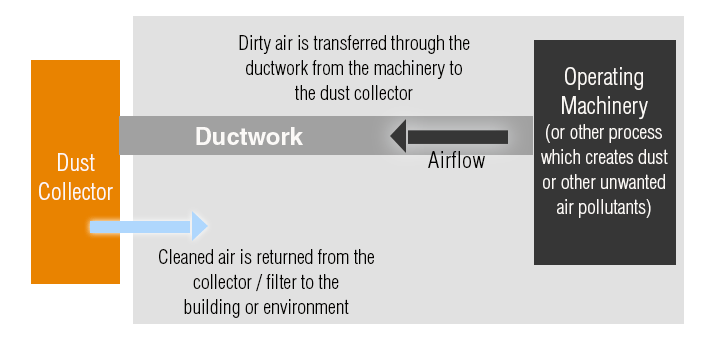
Dust collection ductwork falls into two major categories—flexible hose duct and hard, fixed duct.
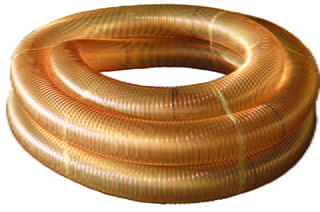 Flexible Hose is a rubber or plastic hose with a metal grounding helix that MUST be grounded at each end to keep static electricity from building up and generating dangerous sparks. Hose is only appropriate for short runs, such as machine connections. That is because its rough interior and “floppy” nature cause significant static pressure loss, which requires higher energy use and can result in poor system performance.
Flexible Hose is a rubber or plastic hose with a metal grounding helix that MUST be grounded at each end to keep static electricity from building up and generating dangerous sparks. Hose is only appropriate for short runs, such as machine connections. That is because its rough interior and “floppy” nature cause significant static pressure loss, which requires higher energy use and can result in poor system performance.
Hard, Fixed Dust Collection Ductwork is usually constructed out of either plastic or metal (galvanized or stainless steel, depending on the application). All-metal construction is used on virtually all industrial and commercial applications as it reduces the chance of dangerous static electricity buildup. The smooth rigid interior of metal duct reduces static pressure loss, even over long runs. Metal duct construction types could include spiral wound or seamed.
Fit-together metal ducting systems are generally available with flanged or clip-together ends / connection types.
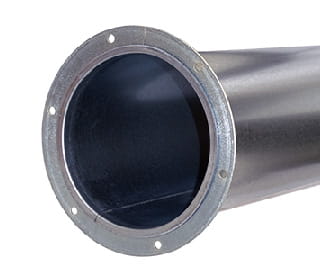 Flanged ducting is joined using metal flanges or angle rings. In this method, flanges are fitted over each end of the duct collar and the edge of the duct is “vanstoned” (turned up to keep the flange in place) or the flange can be welded to the duct. Then the flanges on the ends of two pieces of duct are simply bolted together to join pieces.
Flanged ducting is joined using metal flanges or angle rings. In this method, flanges are fitted over each end of the duct collar and the edge of the duct is “vanstoned” (turned up to keep the flange in place) or the flange can be welded to the duct. Then the flanges on the ends of two pieces of duct are simply bolted together to join pieces.
Drawbacks of flanged construction are:
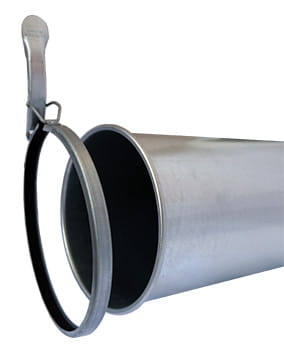 Clip Together ductwork systems, such as Nordfab Quick-Fit (QF), in which each section of duct has a rolled edge that is joined quickly with a simple tool-free clip, offer many advantages, including:
Clip Together ductwork systems, such as Nordfab Quick-Fit (QF), in which each section of duct has a rolled edge that is joined quickly with a simple tool-free clip, offer many advantages, including:
Nordfab is the originator and world's largest manufacturer of clip-together ducting.
Learn more about the benefits of using clip together ducting | View our QF Clip Together Ducting
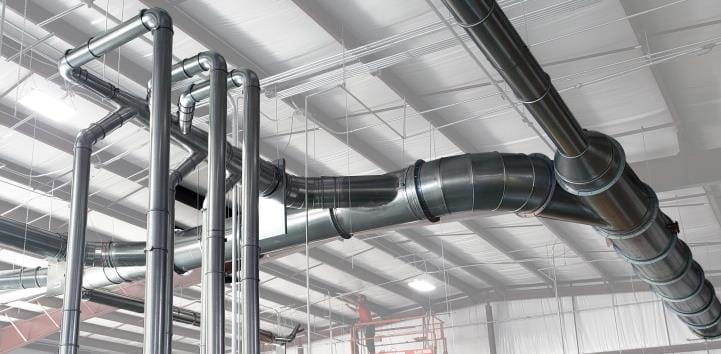
Above: Nordfab Quick-Fit (QF) and flanged ductwork installed in an industrial dust collection system
It looks like you're coming from United States.
Would you like to go to the United States site?